Building a serverless hosting platform
Deploying a 3-tier application (with the presentation layer, business logic, and storage) can get a little tricky these days. Let’s say that we have a simple Django application, poll’s app from the tutorial. It runs perfect on our local machine, we added a requirements.txt to hold our dependencies. As for the database, we can use SQLite, since we’re developing only locally. The purpose of this project is to build a system that will allow us to push on a branch and deploy our changes in a separate environment, giving us a unique URL, to check them. Similarly to how now.sh and heroku.com are doing. We’ll need a mechanism that will package our code and dependencies and will deploy it, but also it needs to consider multiple versions, upgrades, load-balacing, scaling and our stateful part (database).
- Packet
- Kubernetes on bare-metal
- MetalLB
- Istio
- First Knative service
- ElasticSearch and Kibana
- Autoscaling
- Mysql
Introduction
In order to achieve that, we’ll need two main components: one component that will take our code and prepare it to be published, namely the CI/CD component, and another one that will expose the changes to the Internet, namely the serving component. We can add a third component to hold some state for our application, like database and storage, but we’ll add it to the serving component.

Serving component
For the serving component, we can use Knative. It leverages Kubernetes and integrates components that are already built on top of Kubernetes. At it’s very basic, it runs and exposes a Docker image to the Internet, without any fuss. You’ll just have to define a service that describe your image and its environment and Knative will take care of everything else (from routing, logging, monitoring to managing different versions of your application and autoscaling, including 0 scaling for no use).
As you can imagine, Knative is way more complex than it can be described in a paragraph and currently, we’ll not dissect it.
Packet
In order to move forward with Knative, we’ll need a Kubernetes cluster. For the sake of over-engineering it and trying something new, let’s try to install Kubernetes on bare-metal. It sounds a little overwhelming, but in the end, it is way simpler than anticipated. I’ve always wanted to try packet.com, since they have automated their deployment (it can be controlled via an API, thus allowing tools like Terraform to shine), they have a marketplace on which you can bid for machine’s usage per hour (called Spot Market, accessible via their API) and neat networking features (like BGP - Border Gateway Protocol, which will need further).
We can choose from 3 deployment types: on-demand, reserved and spot. Let’s try the spot instances since those can be really cheap.
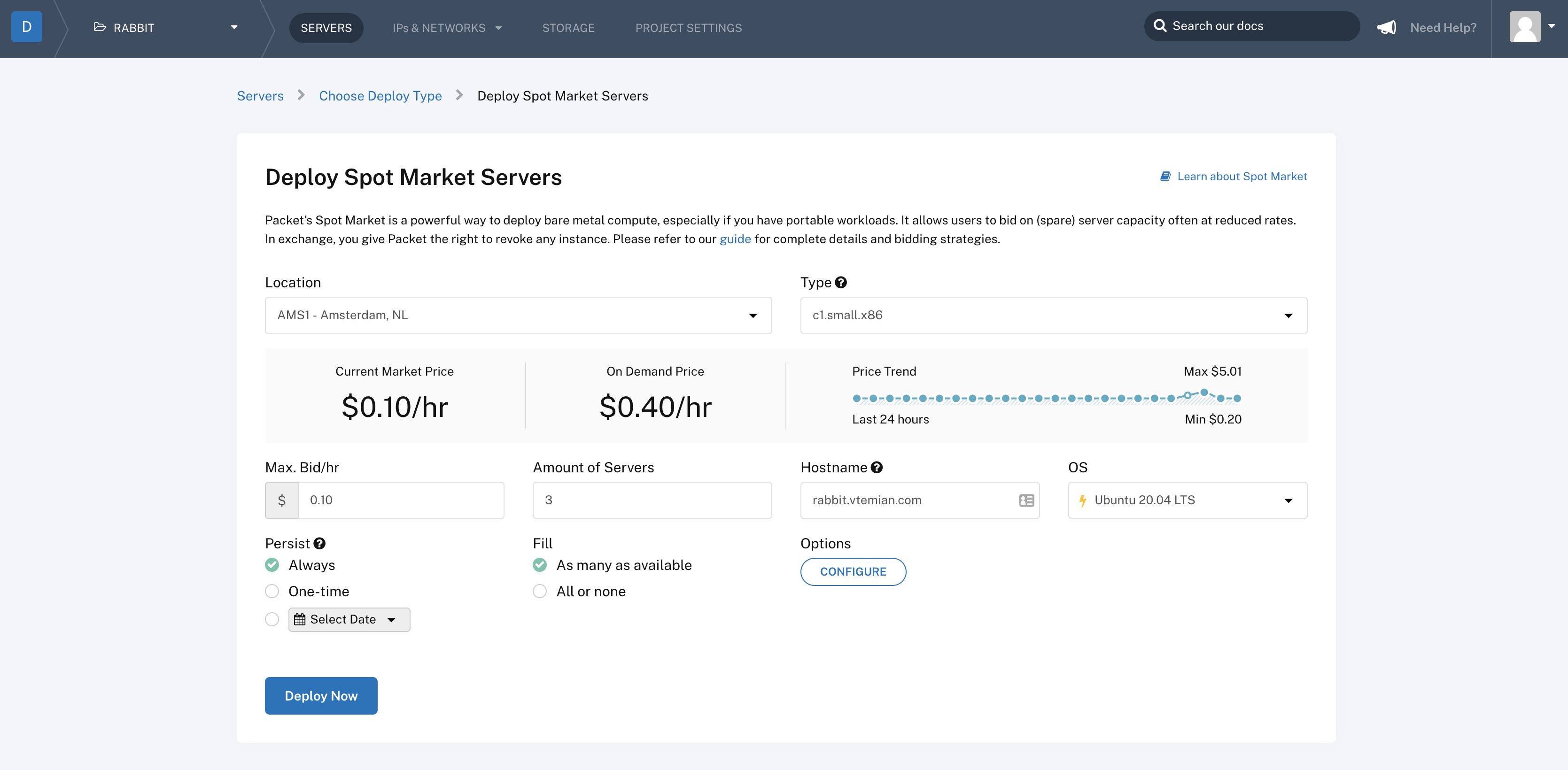
Once a spot market request was created, it will check for available machines that comply with your bid, and start provisioning them. For a max bid of $0.10 / h, we get a c1.small.x86 instance, with 4 physical cores running at 3.4Ghz (Intel E3-1240 v3), 32GB RAM, 2 x 120GB SSD and 2 Gigabit NICs.
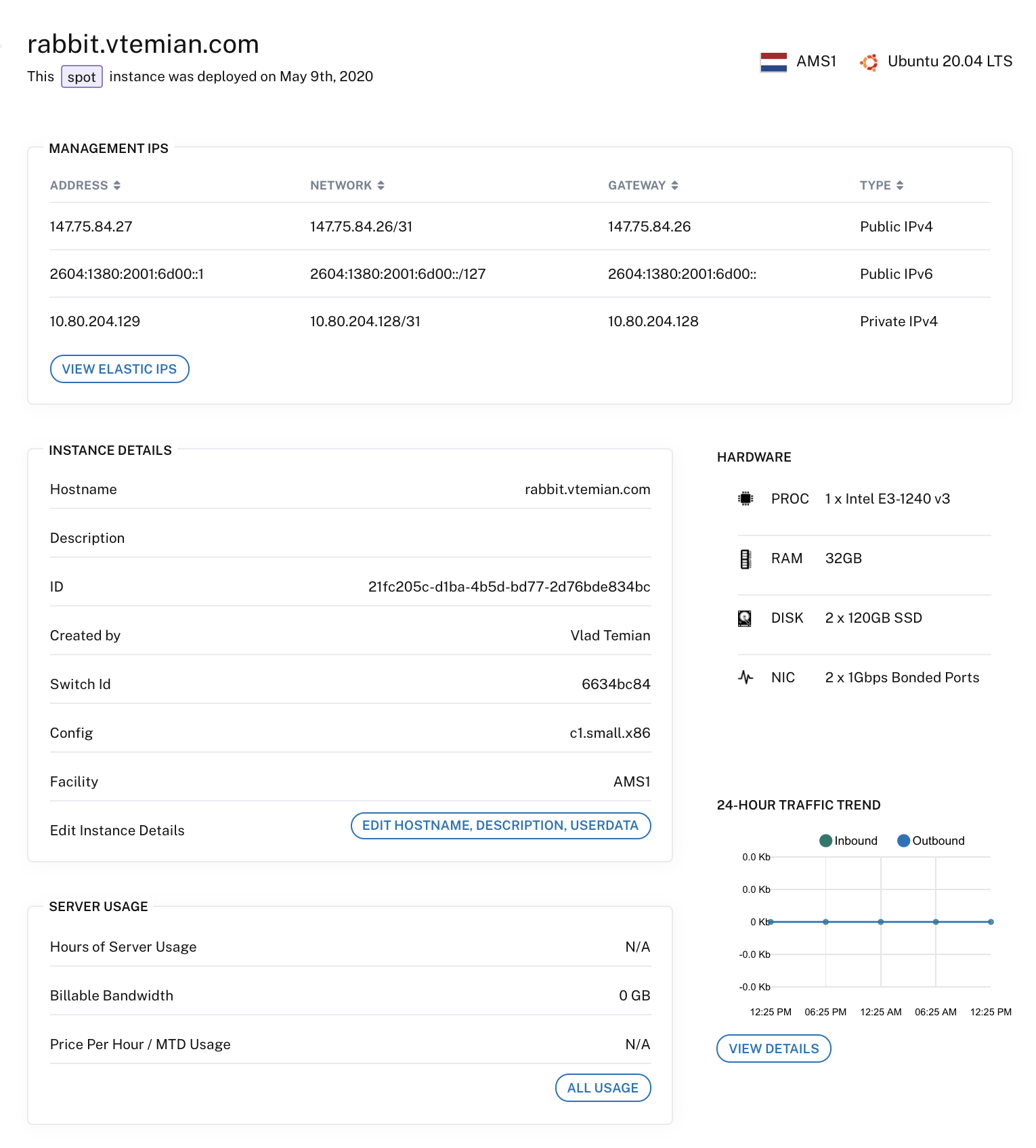
I’ve updated the hostname for each of one and now we’re ready to install Kubernetes.
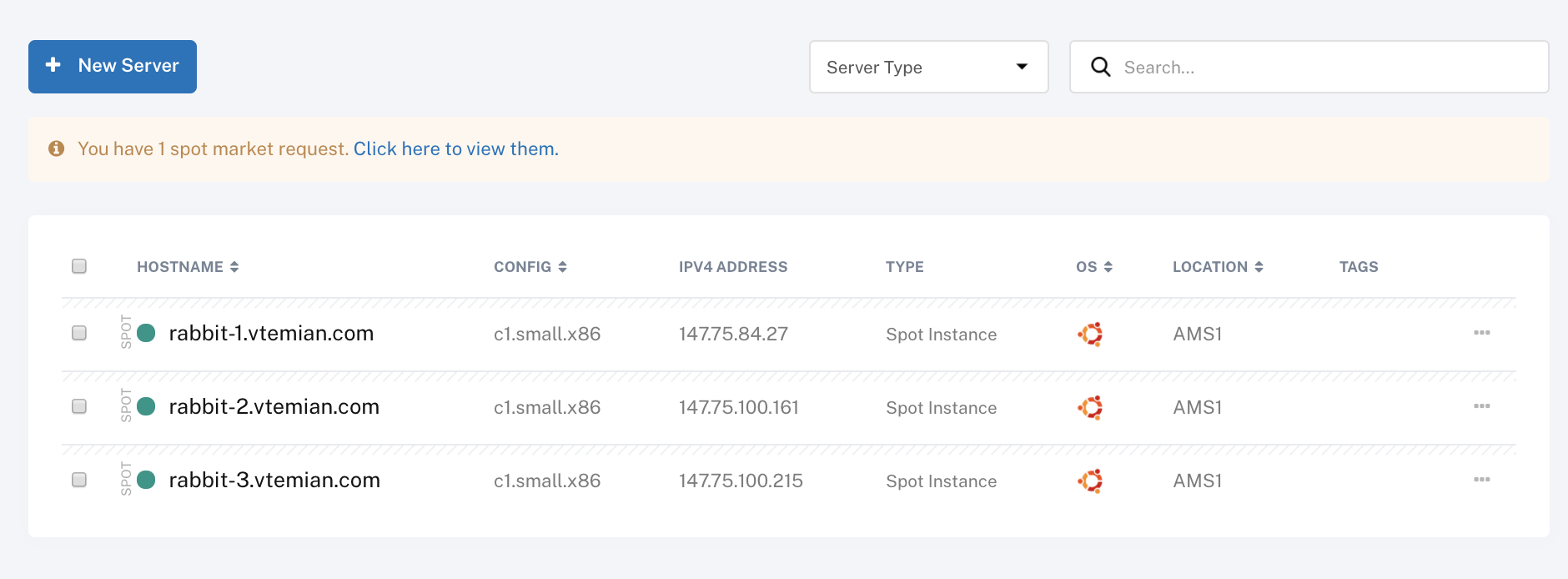
Kubernetes on bare-metal
There are tons of guides out there on how to install Kubernetes on bare metal, from installing all the components manually to using scripts or other tools. The most popular choices are kops, kubeadm and kubespray. I went with kubespray since, for me, it was easier to understand and it was the path with the least resistance to follow since I have some ansible experience. Here you can find a small comparison between kops, kubeadm, and kubespray.
Kubespray is easy to install and to use. We just need to clone the repository and install it using
sudo pip3 install -r requirements.txt
We can also install it in a separate virtual environment if we have different versions of ansible running on your machine.
Next, we need to define an inventory of servers. It comes with pre-defined inventory examples. We can use Packet’s API to list all your servers, but I decided to use a static one. Just copy the sample inventory into a separate one (I’ve called it rabbit).
cd kubespray
cp -R inventory/sample/ intentory/rabbit
Now add our servers in inventory.ini
[all]
rabbit-1.vtemian.com ansible_host=147.75.84.27 ansible_user=root ip=10.80.204.129 etcd_member_name=etcd1
rabbit-2.vtemian.com ansible_host=147.75.100.161 ansible_user=root ip=10.80.204.131 etcd_member_name=etcd2
rabbit-3.vtemian.com ansible_host=147.75.100.215 ansible_user=root ip=10.80.204.133 etcd_member_name=etcd3
[kube-master]
rabbit-1.vtemian.com
[etcd]
rabbit-1.vtemian.com
[kube-node]
rabbit-2.vtemian.com
rabbit-3.vtemian.com
[calico-rr]
[k8s-cluster:children]
kube-master
kube-node
calico-rr
Because when I was setting up my cluster, kubespray didn’t fully supported Ubuntu 20.04, I had to update the tasks a little bit. I’ve replaced python-minimal with python2-minimal and install Docker from Ubuntu 19.10 (Eoan) repositories.
Next, we just need to run ansible and let it do the magic.
ansible-playbook --become -i inventory/rabbit/inventory.ini cluster.yml
If everything worked as intended, we’ll have a new cluster, up and running. In order to access it, we can grab the admin credentials, from the kube-master node.
scp root@rabbit-1.vtemian.com:/etc/kubernetes/admin.conf .
Next, add those into our local kubectl config (usually located at ~/.kube/config) and we’ll be able to access the cluster, using kubectl.
╰─>$ kubectl get pod --all-namespaces -o wide
NAMESPACE NAME READY STATUS RESTARTS AGE IP NODE NOMINATED NODE READINESS GATES
kube-system calico-kube-controllers-5679c8548f-rffvp 1/1 Running 0 2m46s 10.80.204.133 rabbit-3.vtemian.com <none> <none>
kube-system calico-node-6wt2p 1/1 Running 1 3m12s 10.80.204.129 rabbit-1.vtemian.com <none> <none>
kube-system calico-node-98cnq 1/1 Running 1 3m12s 10.80.204.131 rabbit-2.vtemian.com <none> <none>
kube-system calico-node-kh9k8 1/1 Running 1 3m12s 10.80.204.133 rabbit-3.vtemian.com <none> <none>
kube-system coredns-76798d84dd-75tz6 1/1 Running 0 2m21s 10.233.82.1 rabbit-1.vtemian.com <none> <none>
kube-system coredns-76798d84dd-bqt66 1/1 Running 0 2m17s 10.233.80.1 rabbit-3.vtemian.com <none> <none>
kube-system dns-autoscaler-85f898cd5c-nskgf 1/1 Running 0 2m18s 10.233.82.2 rabbit-1.vtemian.com <none> <none>
kube-system kube-apiserver-rabbit-1.vtemian.com 1/1 Running 0 4m58s 10.80.204.129 rabbit-1.vtemian.com <none> <none>
kube-system kube-controller-manager-rabbit-1.vtemian.com 1/1 Running 0 4m58s 10.80.204.129 rabbit-1.vtemian.com <none> <none>
kube-system kube-proxy-4ktbs 1/1 Running 0 3m34s 10.80.204.131 rabbit-2.vtemian.com <none> <none>
kube-system kube-proxy-kd6n2 1/1 Running 0 3m34s 10.80.204.133 rabbit-3.vtemian.com <none> <none>
kube-system kube-proxy-ts8nw 1/1 Running 0 3m34s 10.80.204.129 rabbit-1.vtemian.com <none> <none>
kube-system kube-scheduler-rabbit-1.vtemian.com 1/1 Running 0 4m58s 10.80.204.129 rabbit-1.vtemian.com <none> <none>
kube-system kubernetes-dashboard-77475cf576-7sdr6 1/1 Running 0 2m15s 10.233.83.2 rabbit-2.vtemian.com <none> <none>
kube-system kubernetes-metrics-scraper-747b4fd5cd-k96pn 1/1 Running 0 2m15s 10.233.83.1 rabbit-2.vtemian.com <none> <none>
kube-system nginx-proxy-rabbit-2.vtemian.com 1/1 Running 0 3m35s 10.80.204.131 rabbit-2.vtemian.com <none> <none>
kube-system nginx-proxy-rabbit-3.vtemian.com 1/1 Running 0 3m36s 10.80.204.133 rabbit-3.vtemian.com <none> <none>
kube-system nodelocaldns-9l6vf 1/1 Running 0 2m17s 10.80.204.133 rabbit-3.vtemian.com <none> <none>
kube-system nodelocaldns-blbcb 1/1 Running 0 2m17s 10.80.204.131 rabbit-2.vtemian.com <none> <none>
kube-system nodelocaldns-vrspt 1/1 Running 0 2m17s 10.80.204.129 rabbit-1.vtemian.com <none> <none>
MetalLB
Going further, we should be able to install Knative. A big step in Knative’s installation is the routing component. It supports multiple networking layers (Ambassador, Contour, Gloo, Istio, and Kourier). The only problem is that those layers need a load balancer that will be exposed to the Internet (an external LoadBalancer). Kubernetes doesn’t have native support for that. Basically, the current implementations are vendor-specific (AWS, GCP, Azure etc.) and because we’re on bare-metal, we can’t afford the luxury of using one of those.
Luckily, there’s an implementation for bare-metal, called MetalLB. It can do that in two ways: at layer 2 using ARP/NDP or by leveraging BGP. Because Packet has support for BGP and they also provide a useful example on how to configure MetalLB, we’ll give them a try.
The instructions from Packet’s BGP - Kubernetes integration are well documented and easy to follow. We just need to be careful with the IPPools. Before defining them, I’ve configured 2 sets of elastic IPs:
A global IP 147.75.40.130/32 and a Public IPv4 147.75.80.160/30.
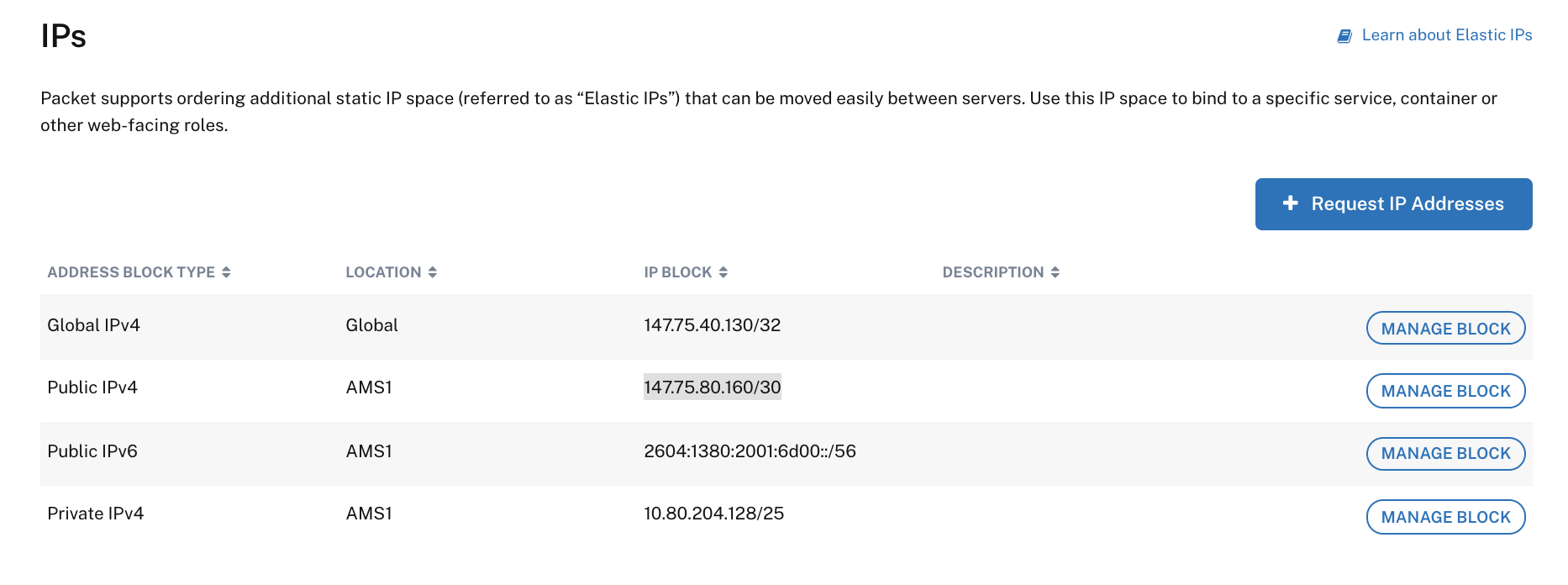
For security reasons, you’ll need to manually configure the IPs, for each server. Its fairly easy to do it and well documented. For each server, attach them an IP from the Network section:
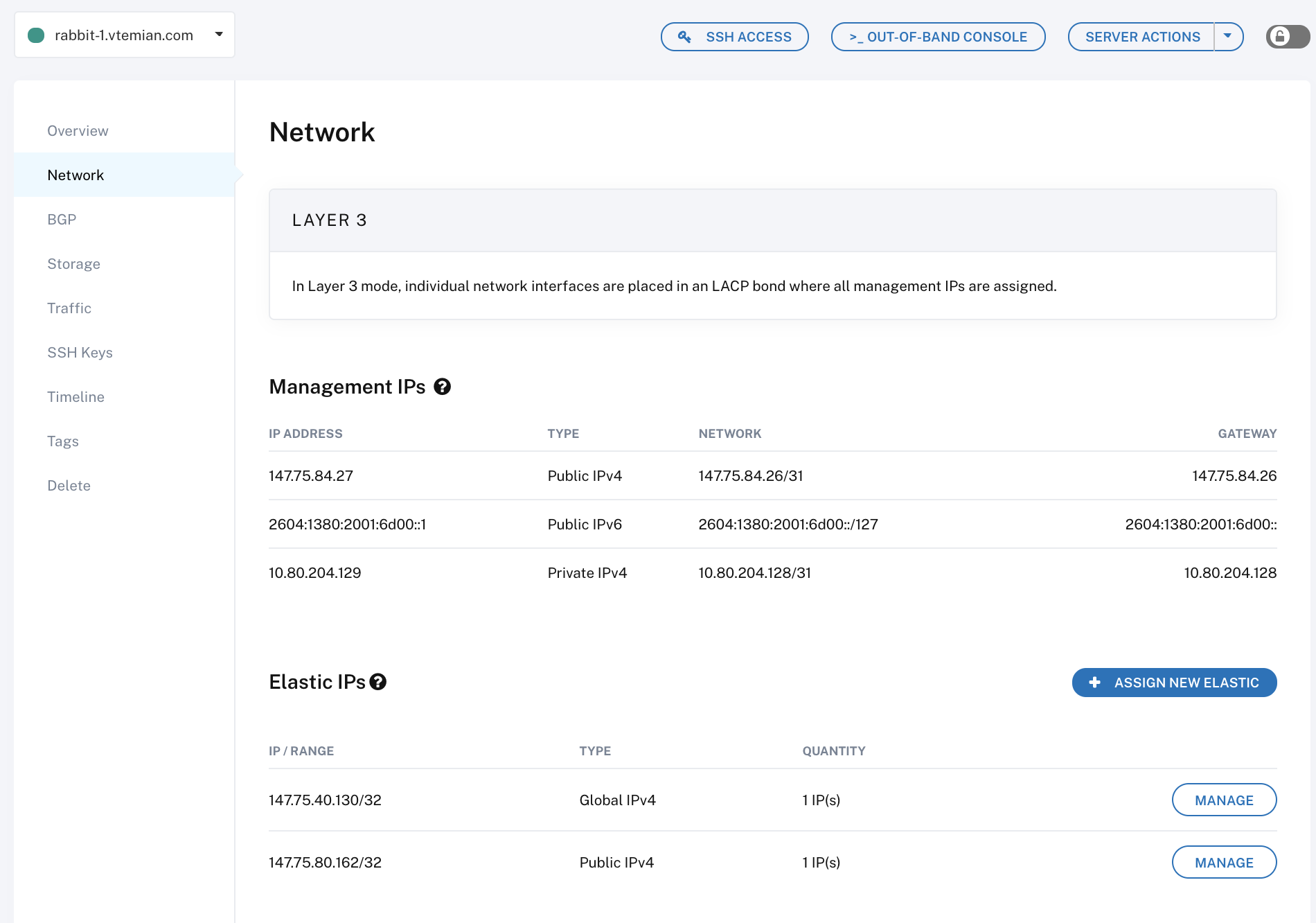
And that, on each server manually (or via ansible), an example for Ubuntu/Debian, if you just want to play around with, run:
sudo ip addr add <elastic-ip> dev lo
To make it permanent, we’ll need to edit /etc/network/interfaces
auto lo:0
iface lo:0 inet static
address <elastic-ip>
netmask 255.255.255.255
Continuing with the IPPools configuration, for metallb-ewr1-public will have 147.75.80.160/30, for metallb-global-ips will have 147.75.40.130/32 and for metallb-private will have our private nodes subnet, which in the current case should be 10.80.204.128/29. You can play around with the node’s private ips and a CIDR-IP conversion tool.
For each calico peer config (worker), we’ll put node’s private IP.
Next, we’ll install the latest metalLB manifest:
kubectl apply -f https://raw.githubusercontent.com/google/metallb/v0.8.1/manifests/metallb.yaml
Followed by the metalLB’s config map, in metallb-system namespace:
apiVersion: v1
kind: ConfigMap
metadata:
namespace: metallb-system
name: config
data:
config: |
peers:
- peer-address: 127.0.0.1
peer-asn: 65000
my-asn: 65480
address-pools:
- name: ewr1-public
protocol: bgp
addresses:
- 147.75.80.160/30
- name: ewr1-private
protocol: bgp
addresses:
- 10.80.204.128/29
- name: global-ip
protocol: bgp
addresses:
- 147.75.40.130/32
We can check if everything is configured correctly, by running calicoctl node status in our master node:
root@rabbit-1:~# calicoctl node status
Calico process is running.
IPv4 BGP status
+----------------+-------------------+-------+----------+-------------+
| PEER ADDRESS | PEER TYPE | STATE | SINCE | INFO |
+----------------+-------------------+-------+----------+-------------+
| 147.75.100.215 | node-to-node mesh | up | 13:46:38 | Established |
| 127.0.0.1 | global | up | 13:51:44 | Established |
| 147.75.100.161 | node-to-node mesh | up | 13:47:27 | Established |
+----------------+-------------------+-------+----------+-------------+
And other kubectl commands:
╰─>$ kubectl get pod -n kube-system -o wide | grep calico-node
calico-node-479fz 1/1 Running 0 8m25s 10.80.204.133 rabbit-3.vtemian.com <none> <none>
calico-node-846gr 1/1 Running 0 7m18s 10.80.204.131 rabbit-2.vtemian.com <none> <none>
calico-node-tpnjc 1/1 Running 0 8m8s 10.80.204.129 rabbit-1.vtemian.com <none> <none>
╰─>$ kubectl get pod -n metallb-system -o wide
NAME READY STATUS RESTARTS AGE IP NODE NOMINATED NODE READINESS GATES
controller-6bcfdfd677-nxnw8 1/1 Running 0 5m4s 10.233.65.193 rabbit-3.vtemian.com <none> <none>
speaker-d6kks 1/1 Running 0 5m4s 10.80.204.131 rabbit-2.vtemian.com <none> <none>
speaker-kk85w 1/1 Running 0 5m4s 10.80.204.133 rabbit-3.vtemian.com <none> <none>
speaker-p4lc7 1/1 Running 0 5m4s 10.80.204.129 rabbit-1.vtemian.com <none> <none>
Istio
Now that we have the MetalLB up and running we can continue with the last routing component. Between all those networking components that Knative supports, I’ve chosen Istio, because it is the only one compatible with the Knative operator (which will be mention further).
We just need to follow the instructions from the main install page and if everything worked, we’ll have a load balancer, with an external IP.
╰─>$ kubectl get service --all-namespaces
NAMESPACE NAME TYPE CLUSTER-IP EXTERNAL-IP PORT(S) AGE
default kubernetes ClusterIP 10.233.0.1 <none> 443/TCP 101m
istio-system istio-ingressgateway LoadBalancer 10.233.24.125 147.75.80.160 15020:30935/TCP,80:31380/TCP,443:31390/TCP,31400:31400/TCP,15029:31350/TCP,15030:31699/TCP,15031:32315/TCP,15032:31519/TCP,15443:32542/TCP 55s
istio-system istio-pilot ClusterIP 10.233.48.55 <none> 15010/TCP,15011/TCP,8080/TCP,15014/TCP 55s
kube-system coredns ClusterIP 10.233.0.3 <none> 53/UDP,53/TCP,9153/TCP 98m
kube-system dashboard-metrics-scraper ClusterIP 10.233.61.223 <none> 8000/TCP 97m
kube-system kubernetes-dashboard ClusterIP 10.233.16.174 <none> 443/TCP 97m
Knative
We’re ready to install Knative. I found that the easier path is to install the common operator that will further install all the components. I’ve tried installing each component manually, but it can get really tricky.
For now, we need to install the operator in the default namespace, since it will look for a ConfigMap called config-loggin in the default namespace.
╰─>$ kubens default
╰─>$ kubectl apply -f https://github.com/knative-sandbox/operator/releases/download/v0.14.1/operator.yaml
Once the CRDs are installed and the operator’s pods are running
╰─>$ kubectl get pods
NAME READY STATUS RESTARTS AGE
knative-eventing-operator-5847fcc5d5-d4cb4 1/1 Running 0 53s
knative-serving-operator-587dcd9f85-zlx7v 1/1 Running 0 53s
We can create the KnativeServing and KnativeEventing resources:
╰─>$ cat <<-EOF | kubectl apply -f -
apiVersion: operator.knative.dev/v1alpha1
kind: KnativeServing
metadata:
name: ks
EOF
╰─>$ cat <<-EOF | kubectl apply -f -
apiVersion: v1
kind: Namespace
metadata:
name: knative-eventing
---
apiVersion: operator.knative.dev/v1alpha1
kind: KnativeEventing
metadata:
name: ke
namespace: knative-eventing
EOF
New pods and resources are being installed in the default and knative-eventing namespaces
╰─>$ kubectl get pods --all-namespaces -o wide
NAMESPACE NAME READY STATUS RESTARTS AGE IP NODE NOMINATED NODE READINESS GATES
default activator-65fc4d666-7bwst 1/1 Running 0 39s 10.233.125.68 rabbit-2.vtemian.com <none> <none>
default autoscaler-74b4bb97bd-ghj59 1/1 Running 0 38s 10.233.65.195 rabbit-3.vtemian.com <none> <none>
default autoscaler-hpa-594f68d5c4-8qtg4 1/1 Running 0 30s 10.233.65.198 rabbit-3.vtemian.com <none> <none>
default controller-6b6978c965-rqb2z 1/1 Running 0 37s 10.233.65.196 rabbit-3.vtemian.com <none> <none>
default istio-webhook-856d84fbf9-wvpph 1/1 Running 0 26s 10.233.125.71 rabbit-2.vtemian.com <none> <none>
default knative-eventing-operator-5847fcc5d5-d4cb4 1/1 Running 0 3m18s 10.233.125.67 rabbit-2.vtemian.com <none> <none>
default knative-serving-operator-587dcd9f85-zlx7v 1/1 Running 0 3m18s 10.233.125.66 rabbit-2.vtemian.com <none> <none>
default networking-istio-6845f7cf59-bsqc2 1/1 Running 0 26s 10.233.125.69 rabbit-2.vtemian.com <none> <none>
default webhook-577576647-wrw56 1/1 Running 0 36s 10.233.65.197 rabbit-3.vtemian.com <none> <none>
istio-system istio-ingressgateway-75694cd848-l6zfh 1/1 Running 0 64m 10.233.125.65 rabbit-2.vtemian.com <none> <none>
istio-system istio-pilot-576d858689-zxv76 1/1 Running 0 64m 10.233.65.194 rabbit-3.vtemian.com <none> <none>
knative-eventing broker-controller-854447b8d7-vdmdz 1/1 Running 0 18s 10.233.65.200 rabbit-3.vtemian.com <none> <none>
knative-eventing broker-filter-b54b58854-w9jvw 1/1 Running 0 17s 10.233.125.72 rabbit-2.vtemian.com <none> <none>
knative-eventing broker-ingress-75b6b8df8d-mlppj 1/1 Running 0 16s 10.233.65.201 rabbit-3.vtemian.com <none> <none>
knative-eventing eventing-controller-694594fdd7-gj2br 1/1 Running 0 26s 10.233.125.70 rabbit-2.vtemian.com <none> <none>
knative-eventing eventing-webhook-6c6b675b6f-t4ntx 1/1 Running 0 26s 10.233.65.199 rabbit-3.vtemian.com <none> <none>
knative-eventing imc-controller-7bb9bd7c6d-q2tsz 1/1 Running 0 10s 10.233.125.73 rabbit-2.vtemian.com <none> <none>
knative-eventing imc-dispatcher-6cc5c74c7f-kdj7v 1/1 Running 0 10s 10.233.125.74 rabbit-2.vtemian.com <none> <none>
knative-eventing mt-broker-controller-75ddc75d57-rg6jd 1/1 Running 0 15s 10.233.65.202 rabbit-3.vtemian.com <none> <none>
knative-eventing v0.14.0-upgrade-4sv89 0/1 Completed 0 9s 10.233.65.203 rabbit-3.vtemian.com <none> <none>
Before we actually test it, let’s configure the DNS component. We’ll want to have a unique URL generated each time a new deployment is created. Knative can do that using xip.io and we just need to create a job (we’ll need to install it in the default namespace):
╰─>$ kubectl apply --filename https://storage.googleapis.com/knative-nightly/serving/latest/serving-default-domain.yaml
First Knative service
Within our initial application, I’ve created a simple Dockerfile:
FROM python:3.7-slim
WORKDIR /app
COPY requirements.txt ./
RUN pip install -r requirements.txt
COPY app ./
CMD exec gunicorn app.wsgi --bind :$PORT --workers 1 --threads 8 --timeout 0
And published the image, publicly, under vtemian/simple-django-app.
╰─>$ docker push vtemian/simple-django-app
The push refers to repository [docker.io/vtemian/simple-django-app]
7aa16540cfca: Pushed
2e02cc50aabc: Pushed
768f0318f857: Pushed
663045c38f65: Pushed
715414420313: Mounted from vtemian/helloworld-python
dba4fa00b93a: Mounted from vtemian/helloworld-python
9f690547ed37: Mounted from vtemian/helloworld-python
6376837eded8: Mounted from vtemian/helloworld-python
c2adabaecedb: Mounted from vtemian/helloworld-python
latest: digest: sha256:78799d85949e31728c70ef3dbf3a492d932fc94c140cf1047d948c89141f55ab size: 2205
To publish it on our Knative installation, we just need to define a service:
apiVersion: serving.knative.dev/v1
kind: Service
metadata:
name: simple-django-app
namespace: default
spec:
template:
spec:
containers:
- image: docker.io/vtemian/simple-django-app
Aaaaaand kubectl get ksvc:
╰─>$ kubectl get ksvc
NAME URL LATESTCREATED LATESTREADY READY REASON
simple-django-app http://simple-django-app.default.147.75.80.160.xip.io simple-django-app-hc2qv Unknown RevisionMissing
Going to the generated URL

Now this…this is pretty damn cool! There’s no database and we still need to build our containers, but it looks pretty damn cool!
ElasticSearch and Kibana
Before we move further to test it more, let’s configure some observability tools, like ElasticSearch + Kibana for logs and Prometheus + Grafana for metrics.
Let’s start with the metrics component. We’ll follow the guide and we’ll just need to edit the config-observability config map. It already provides us with an config example, we’ll be using it. Just unindent the exemple, for now. Next, we’ll need to create the knative-monitoring namespace, and apply the manifests:
╰─>$ kubectl apply --filename https://storage.googleapis.com/knative-nightly/serving/latest/monitoring-metrics-prometheus.yaml
The pods should be up and running in the knative-monitoring namespace:
╰─>$ kubectl get pod -n knative-monitoring -o wide
NAME READY STATUS RESTARTS AGE IP NODE NOMINATED NODE READINESS GATES
grafana-c9c94bdff-5f77v 1/1 Running 0 2m3s 10.233.65.210 rabbit-3.vtemian.com <none> <none>
kube-state-metrics-b6bcff8f4-tvp46 1/1 Running 0 2m7s 10.233.65.209 rabbit-3.vtemian.com <none> <none>
node-exporter-9wkpn 2/2 Running 0 2m4s 10.80.204.131 rabbit-2.vtemian.com <none> <none>
node-exporter-lfjss 2/2 Running 0 2m4s 10.80.204.129 rabbit-1.vtemian.com <none> <none>
node-exporter-zjl7b 2/2 Running 0 2m4s 10.80.204.133 rabbit-3.vtemian.com <none> <none>
prometheus-system-0 1/1 Running 0 2m1s 10.233.65.211 rabbit-3.vtemian.com <none> <none>
prometheus-system-1 1/1 Running 0 2m1s 10.233.125.75 rabbit-2.vtemian.com <none> <none>
By default, Grafana comes with some really nice dashboards and with Prometheus configured as a data source. The only problem is that the Prometheus configured, is not the currently running service. We’ll need to get all currently running services and check Prometheus service name, which in this case is prometheus-system-discovery.
╰─>$ kubectl -n knative-monitoring get service
NAME TYPE CLUSTER-IP EXTERNAL-IP PORT(S) AGE
kube-controller-manager ClusterIP None <none> 10252/TCP 5m36s
kube-state-metrics ClusterIP 10.233.56.244 <none> 8080/TCP,8081/TCP 5m41s
node-exporter ClusterIP None <none> 9100/TCP 5m38s
prometheus-system-discovery ClusterIP None <none> 9090/TCP 5m36s
We’ll have to edit Grafana’s config map and replace Prometheus’ URL with [http://prometheus-system-discovery.knative-monitoring.svc:9090](http://prometheus-system-discovery.knative-monitoring.svc:9090/).
╰─>$ kubectl -n knative-monitoring edit cm grafana-datasources
apiVersion: v1
data:
prometheus.yaml: |
datasources:
- name: prometheus
type: prometheus
access: proxy
org_id: 1
url: http://prometheus-system-discovery.knative-monitoring.svc:9090
version: 1
editable: false
Delete the current running Grafana pod
╰─>$ kubectl delete po -n knative-monitoring --selector=app=grafana
pod "grafana-c9c94bdff-rkvrg" deleted
Wait until a new pod is started and you can port-forward it
╰─>$ kubectl port-forward --namespace knative-monitoring \
(kubectl get pods --namespace knative-monitoring \
--selector=app=grafana --output=jsonpath="{.items..metadata.name}") \
3000
Forwarding from 127.0.0.1:3000 -> 3000
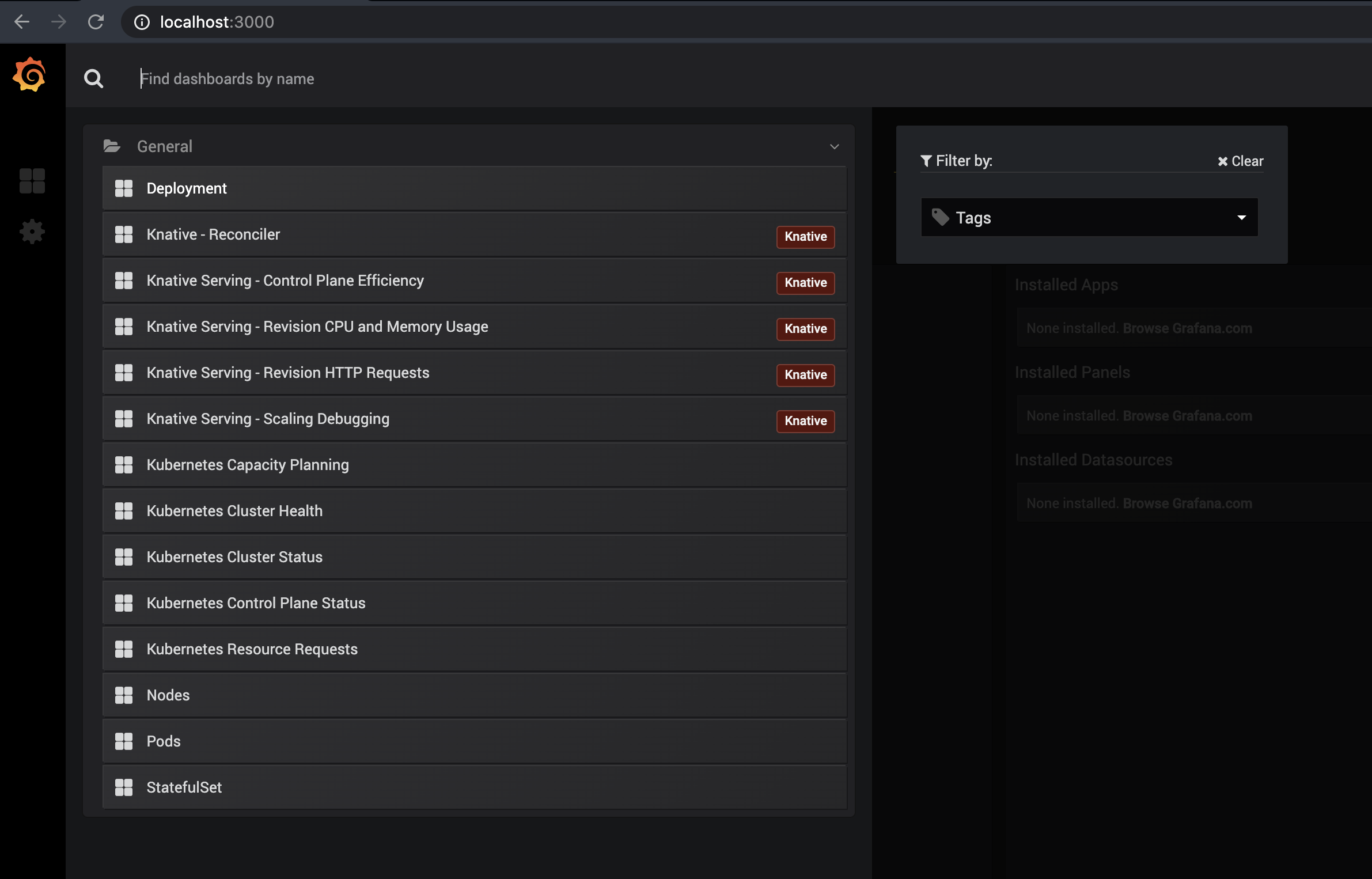
All of those default dashboards are interesting, but I found the most useful the Knative Serving - Revision HTTP Requests, that describes current running applications.
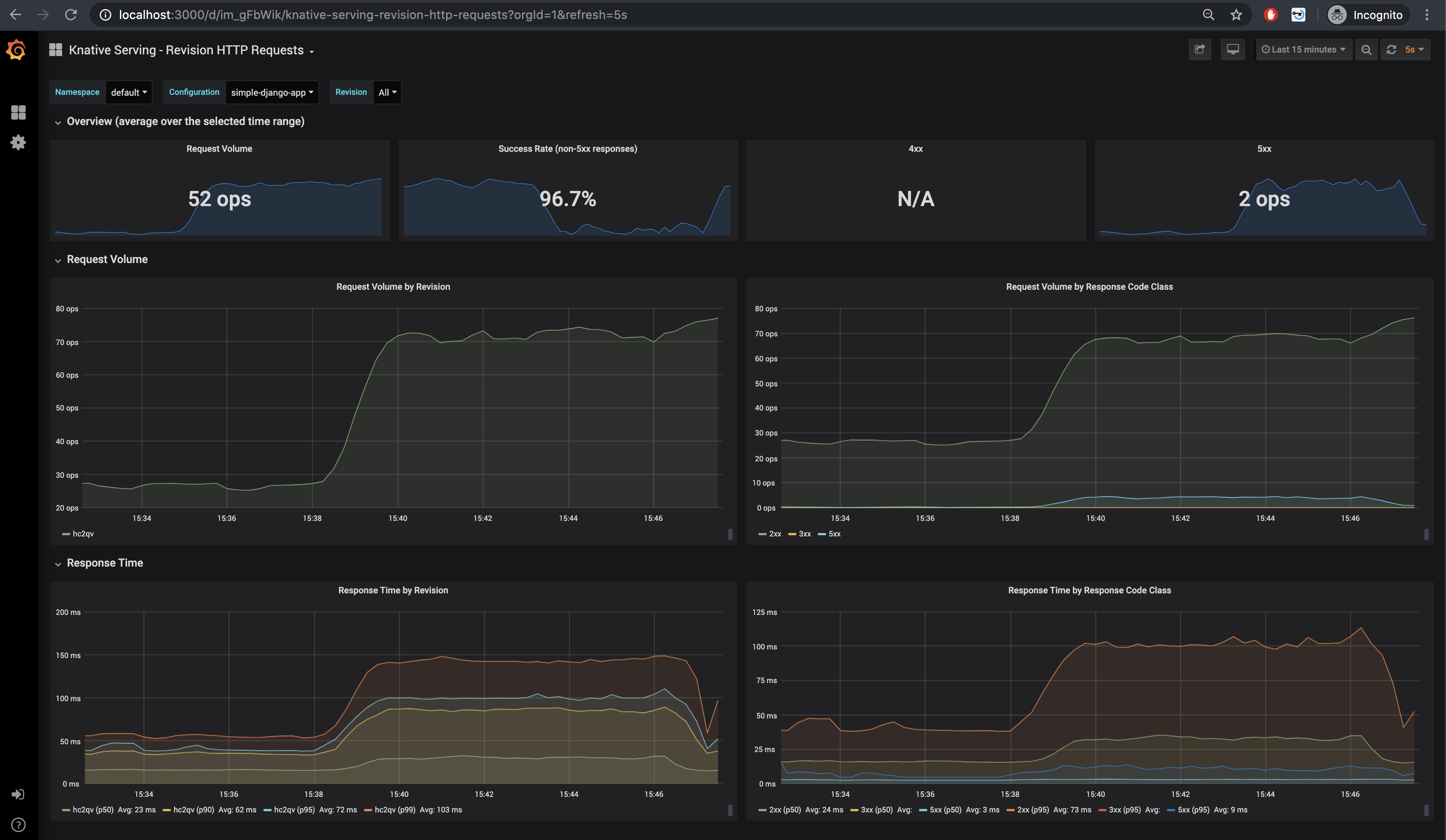
And the Kubernetes Capacity Planning that gives an overview over the entire cluster.
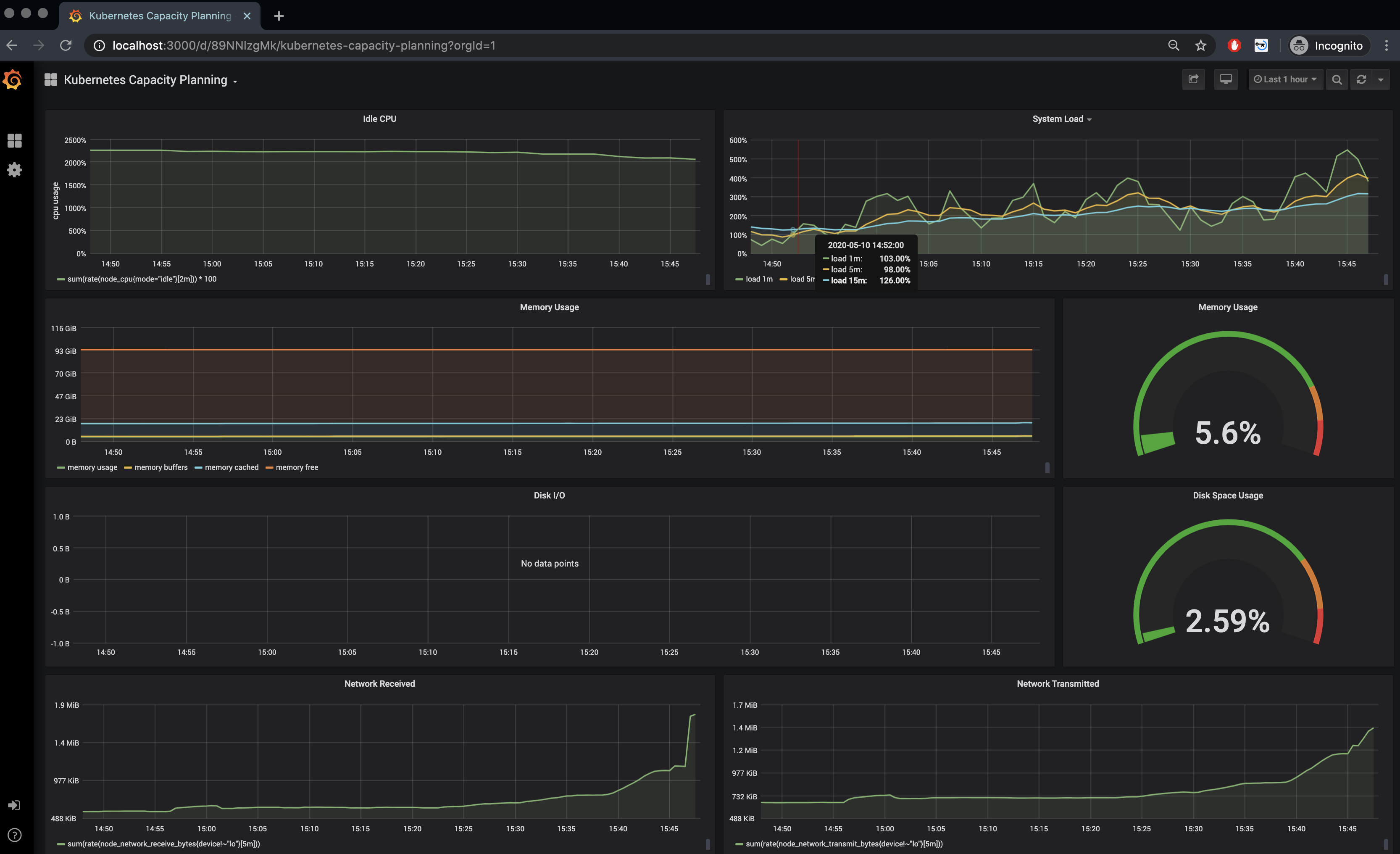
Moving to logs, we’ll need to configure ElasticSearch and Kibana. We’ll need to edit the config-observability ConfigMap and set the logging.request-log-template to
╰─>$ kubectl edit cm config-observability
logging.request-log-template: '{"httpRequest": {"requestMethod": "{{.Request.Method}}", "requestUrl": "{{js .Request.RequestURI}}", "requestSize": "{{.Request.ContentLength}}", "status": {{.Response.Code}}, "responseSize": "{{.Response.Size}}", "userAgent": "{{js .Request.UserAgent}}", "remoteIp": "{{js .Request.RemoteAddr}}", "serverIp": "{{.Revision.PodIP}}", "referer": "{{js .Request.Referer}}", "latency": "{{.Response.Latency}}s", "protocol": "{{.Request.Proto}}"}, "traceId": "{{index .Request.Header "X-B3-Traceid"}}"}'
Apply the manifest
╰─>$ kubectl apply --filename https://storage.googleapis.com/knative-nightly/serving/latest/monitoring-logs-elasticsearch.yaml
We’ll set [beta.kubernetes.io/fluentd-ds-ready="true"](http://beta.kubernetes.io/fluentd-ds-ready=%22true%22) label for our nodes
╰─>$ kubectl label nodes --all beta.kubernetes.io/fluentd-ds-ready="true"
node/rabbit-1.vtemian.com labeled
node/rabbit-2.vtemian.com labeled
node/rabbit-3.vtemian.com labeled
And check if the fluentd daemon set is running on our nodes
╰─>$ kubectl get daemonset fluentd-ds --namespace knative-monitoring
NAME DESIRED CURRENT READY UP-TO-DATE AVAILABLE NODE SELECTOR AGE
fluentd-ds 2 2 2 2 2 beta.kubernetes.io/fluentd-ds-ready=true 5m37s
In this point, on each node a Fluentd daemon is running, collecting logs and send them to ElasticSearch. Furthermore, we’ll need to configure Kibana to access those logs.
We’ll start the local proxy
╰─>$kubectl proxy
And visit Kibana UI. If the service doesn’t start, you can create one with the following configuration
apiVersion: v1
kind: Service
metadata:
name: kibana-logging
namespace: knative-monitoring
labels:
app: kibana-logging
kubernetes.io/cluster-service: "true"
kubernetes.io/name: "Kibana"
spec:
ports:
- port: 5601
protocol: TCP
targetPort: ui
selector:
app: kibana-logging
Create a new index and wait until is processed.
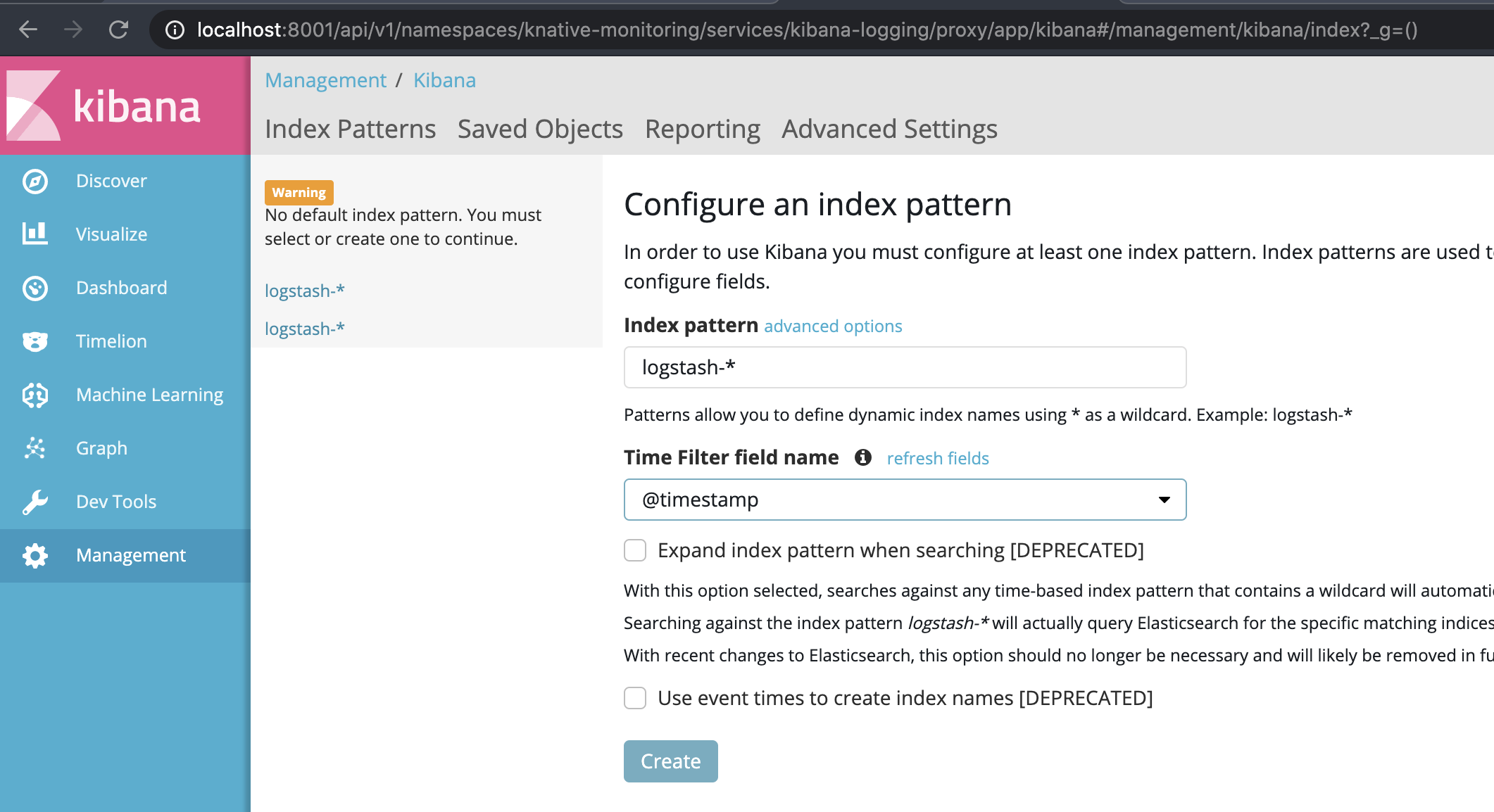
Set it as the default index
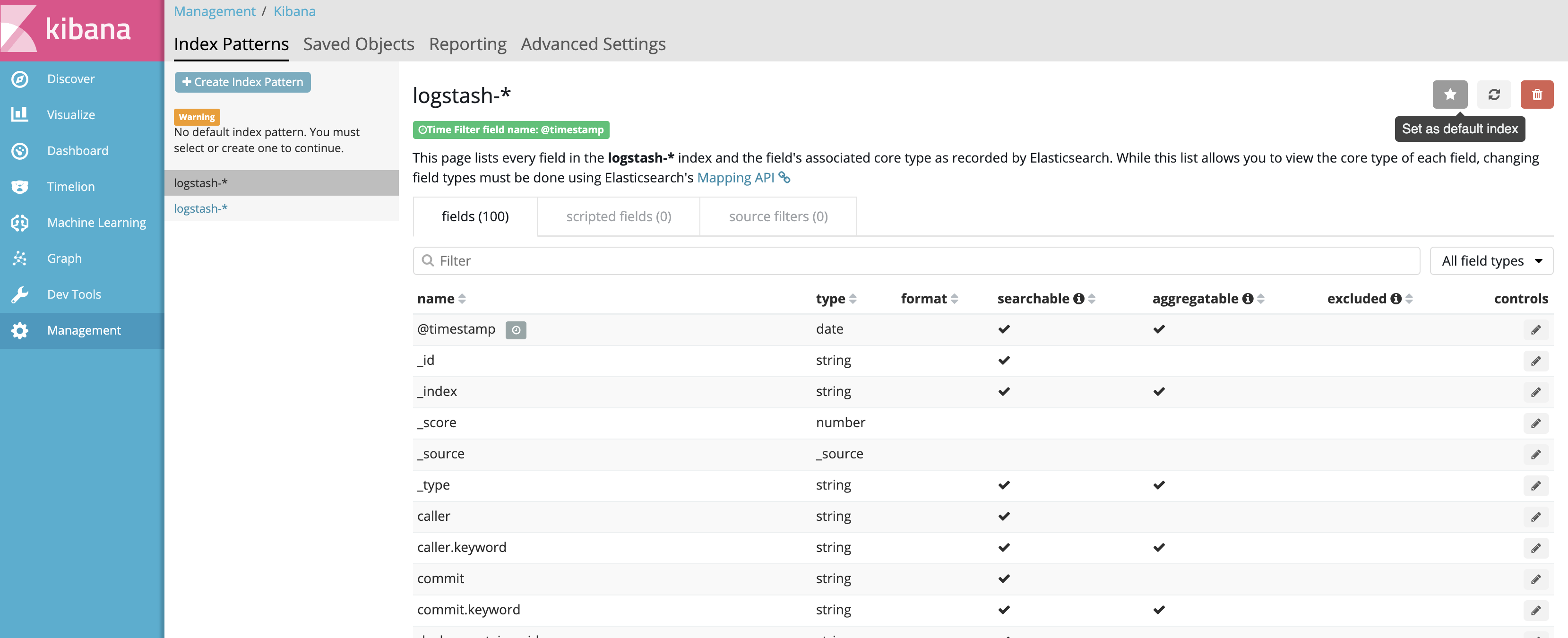
And the logs should flow
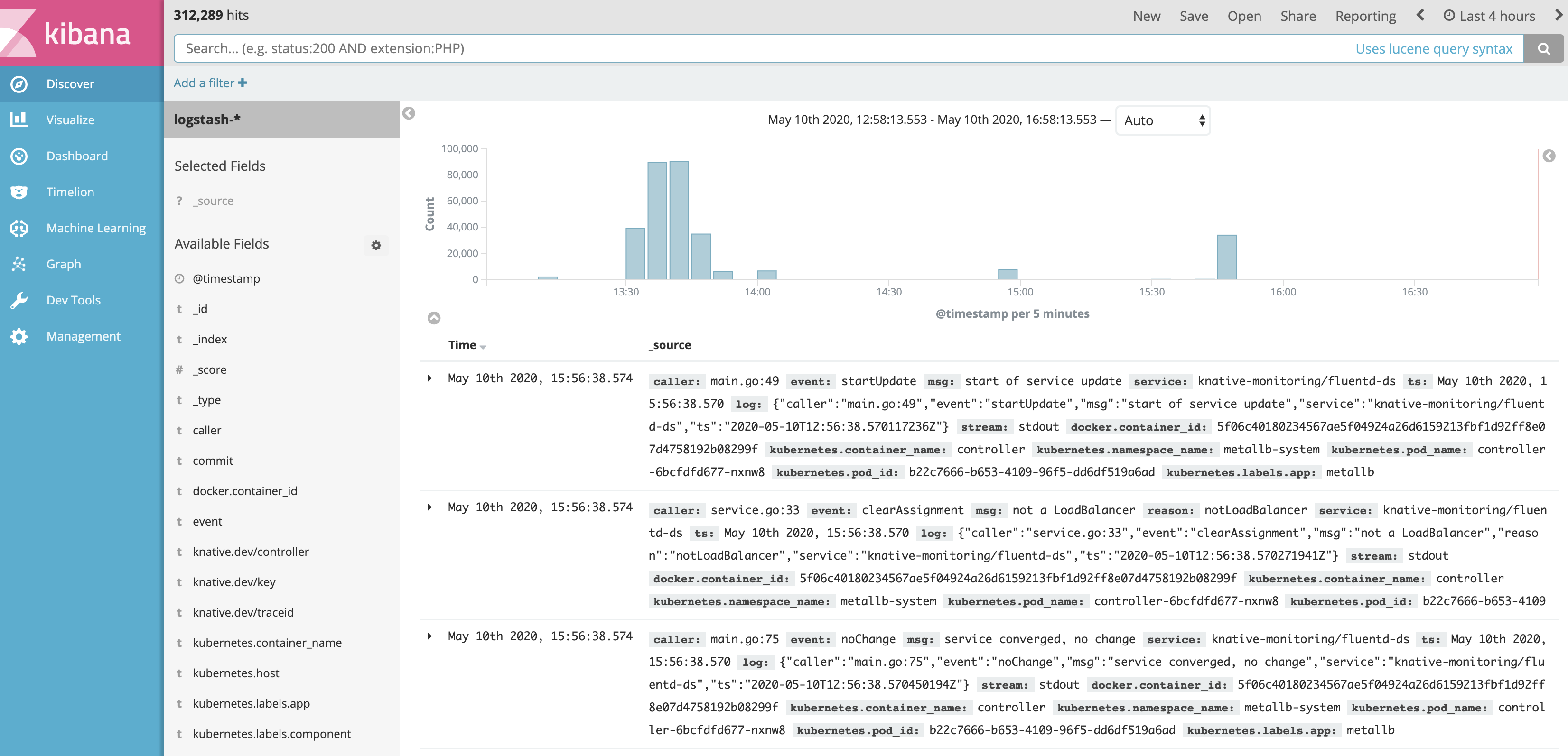
Autoscaling
Now that we can really see what is happening in the cluster, let’s configure the autoscaling and 0 scaling. For that, we’ll need to edit the config-autoscaler ConfigMap. All options are already described in the comments, and for testing purpose, this is the configuration I’m using:
activator-capacity: "100.0"
container-concurrency-target-default: "100"
container-concurrency-target-percentage: "70"
enable-graceful-scaledown: "true"
enable-scale-to-zero: "true"
max-scale-down-rate: "2.0"
max-scale-up-rate: "1000.0"
panic-threshold-percentage: "20.0"
panic-window-percentage: "5.0"
pod-autoscaler-class: kpa.autoscaling.knative.dev
requests-per-second-target-default: "20"
scale-to-zero-grace-period: 30s
stable-window: 60s
target-burst-capacity: "10"
tick-interval: 2s
All those options are explained in the docs, but maybe what we’re most interested are the 0 scaling
# specifies the time an inactive revision is left running before it is scaled to zero (min: 6s).
scale-to-zero-grace-period: 30s
# enables scale to zero
enable-scale-to-zero: "true"
And the autoscaling trasholds
# defines how many concurrent requests are wanted at a given time (soft limit) and is the recommended configuration for autoscaling.
container-concurrency-target-default: "100"
Those are the configuration applied for each revision, but you can control independently, using annotations. Let’s configure the Horizontal Pod Autoscaler to follow the CPU metric and scale if the current consumed CPU is 30% of the limit.
apiVersion: serving.knative.dev/v1
kind: Service
metadata:
name: simple-django-app
namespace: default
spec:
template:
metadata:
annotations:
autoscaling.knative.dev/metric: cpu
autoscaling.knative.dev/target: "70"
autoscaling.knative.dev/class: hpa.autoscaling.knative.dev
spec:
containers:
- image: docker.io/vtemian/simple-django-app
resources:
requests:
cpu: 100m
Let’s start a curl in background
╰─>$ watch -n 0.1 curl -SI http://simple-django-app.default.147.75.80.160.xip.io/polls/
And we have 2 running pods
╰─>$ kubectl get po -l serving.knative.dev/service=simple-django-app
NAME READY STATUS RESTARTS AGE
simple-django-app-g9zf5-deployment-5b76fdf7fc-mtlwt 2/2 Running 0 3m25s
simple-django-app-mg96q-deployment-7db5bb6b9c-29ffw 2/2 Running 0 4m18s
Let’s go further and start a Locust test. We’ll follow the instructions from zalando-incubator and start for replicas that will hit our service:
_________________________________________________________________________________
L O C A L - D E P L O Y M E N T
_________________________________________________________________________________
Target url: http://simple-django-app.default.147.75.80.160.xip.io/polls
Where load test script is stored (e.g. https://raw.githubusercontent.com/zalando-incubator/docker-locust/master/example/simple.py): https://raw.githubusercontent.com/zalando-incubator/docker-locust/master/example/simple.py
Number of slave(s): 4
Run type [automatic/manual]: manual
----------------------------------------------
VARIABLES
----------------------------------------------
TARGET_URL: http://simple-django-app.default.147.75.80.160.xip.io/polls
LOCUST_FILE: https://raw.githubusercontent.com/zalando-incubator/docker-locust/master/example/simple.py
SLAVES NUMBER: 4
RUN_TYPE: manual || automatic=false
NUMBER OF USERS:
HATCH_RATE:
DURATION [in seconds]:
COMPOSE: false
SEND_ANONYMOUS_USAGE_INFO: true
----------------------------------------------
And the results are pretty cool
╰─>$ kubectl get po -l serving.knative.dev/service=simple-django-app
NAME READY STATUS RESTARTS AGE
simple-django-app-ns6fm-deployment-85cff985d5-249rj 2/2 Running 0 41s
simple-django-app-ns6fm-deployment-85cff985d5-2c6m9 2/2 Running 0 41s
simple-django-app-ns6fm-deployment-85cff985d5-2m6kk 2/2 Running 0 86s
simple-django-app-ns6fm-deployment-85cff985d5-2mm7t 2/2 Running 0 41s
simple-django-app-ns6fm-deployment-85cff985d5-2q7f8 2/2 Running 0 41s
simple-django-app-ns6fm-deployment-85cff985d5-5xcxf 2/2 Running 0 71s
simple-django-app-ns6fm-deployment-85cff985d5-6jxfw 2/2 Running 0 41s
simple-django-app-ns6fm-deployment-85cff985d5-77v6w 2/2 Running 0 41s
simple-django-app-ns6fm-deployment-85cff985d5-8qk5s 2/2 Running 0 56s
simple-django-app-ns6fm-deployment-85cff985d5-9n4h6 2/2 Running 0 41s
simple-django-app-ns6fm-deployment-85cff985d5-b466k 2/2 Running 0 7m57s
simple-django-app-ns6fm-deployment-85cff985d5-b8qbf 2/2 Running 0 25s
simple-django-app-ns6fm-deployment-85cff985d5-bkt66 2/2 Running 0 71s
simple-django-app-ns6fm-deployment-85cff985d5-bxbzf 2/2 Running 0 56s
simple-django-app-ns6fm-deployment-85cff985d5-d5xt5 2/2 Running 0 41s
simple-django-app-ns6fm-deployment-85cff985d5-jrchv 2/2 Running 0 41s
simple-django-app-ns6fm-deployment-85cff985d5-mtrvh 2/2 Running 0 56s
simple-django-app-ns6fm-deployment-85cff985d5-mzz7g 2/2 Running 0 41s
simple-django-app-ns6fm-deployment-85cff985d5-p7wvx 2/2 Running 0 41s
simple-django-app-ns6fm-deployment-85cff985d5-pbmzb 2/2 Running 0 25s
simple-django-app-ns6fm-deployment-85cff985d5-pzb92 2/2 Running 0 56s
simple-django-app-ns6fm-deployment-85cff985d5-pzkrr 2/2 Running 0 41s
simple-django-app-ns6fm-deployment-85cff985d5-qhjxq 2/2 Running 0 41s
simple-django-app-ns6fm-deployment-85cff985d5-rc2xx 2/2 Running 0 41s
simple-django-app-ns6fm-deployment-85cff985d5-s7lzm 2/2 Running 0 25s
simple-django-app-ns6fm-deployment-85cff985d5-sdpmf 2/2 Running 0 41s
simple-django-app-ns6fm-deployment-85cff985d5-ss66c 2/2 Running 0 6m27s
simple-django-app-ns6fm-deployment-85cff985d5-ssrzg 2/2 Running 0 56s
simple-django-app-ns6fm-deployment-85cff985d5-t424m 2/2 Running 0 56s
simple-django-app-ns6fm-deployment-85cff985d5-tjlsz 2/2 Running 0 71s
simple-django-app-ns6fm-deployment-85cff985d5-tzcjw 2/2 Running 0 56s
simple-django-app-ns6fm-deployment-85cff985d5-w2tsp 2/2 Running 0 71s
simple-django-app-ns6fm-deployment-85cff985d5-x9626 2/2 Running 0 41s
simple-django-app-ns6fm-deployment-85cff985d5-xm5pk 2/2 Running 0 86s
simple-django-app-ns6fm-deployment-85cff985d5-xv9sw 2/2 Running 0 56s
Requests leaving the local machine
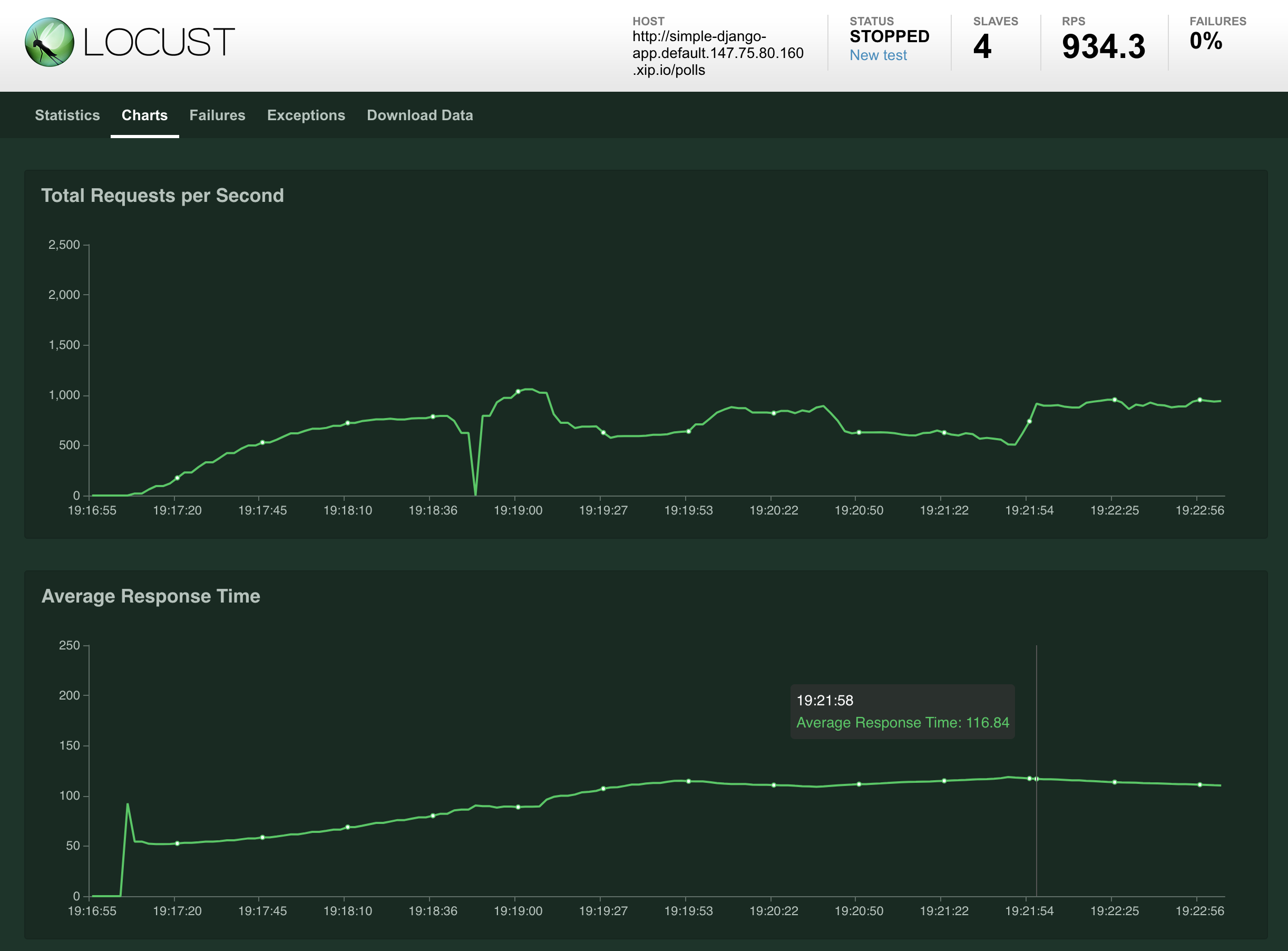
Requests for this current revision
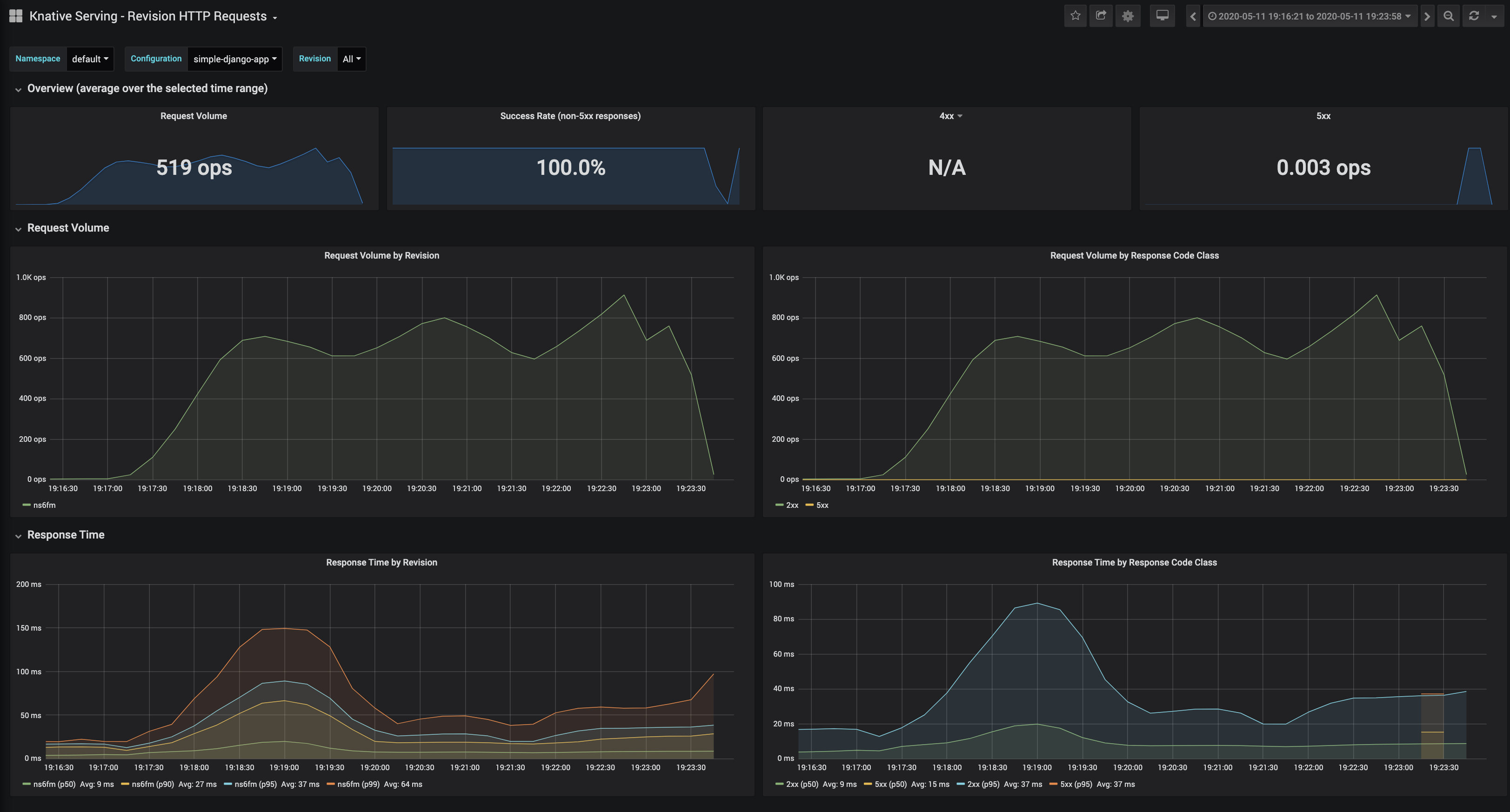
Resource consumption
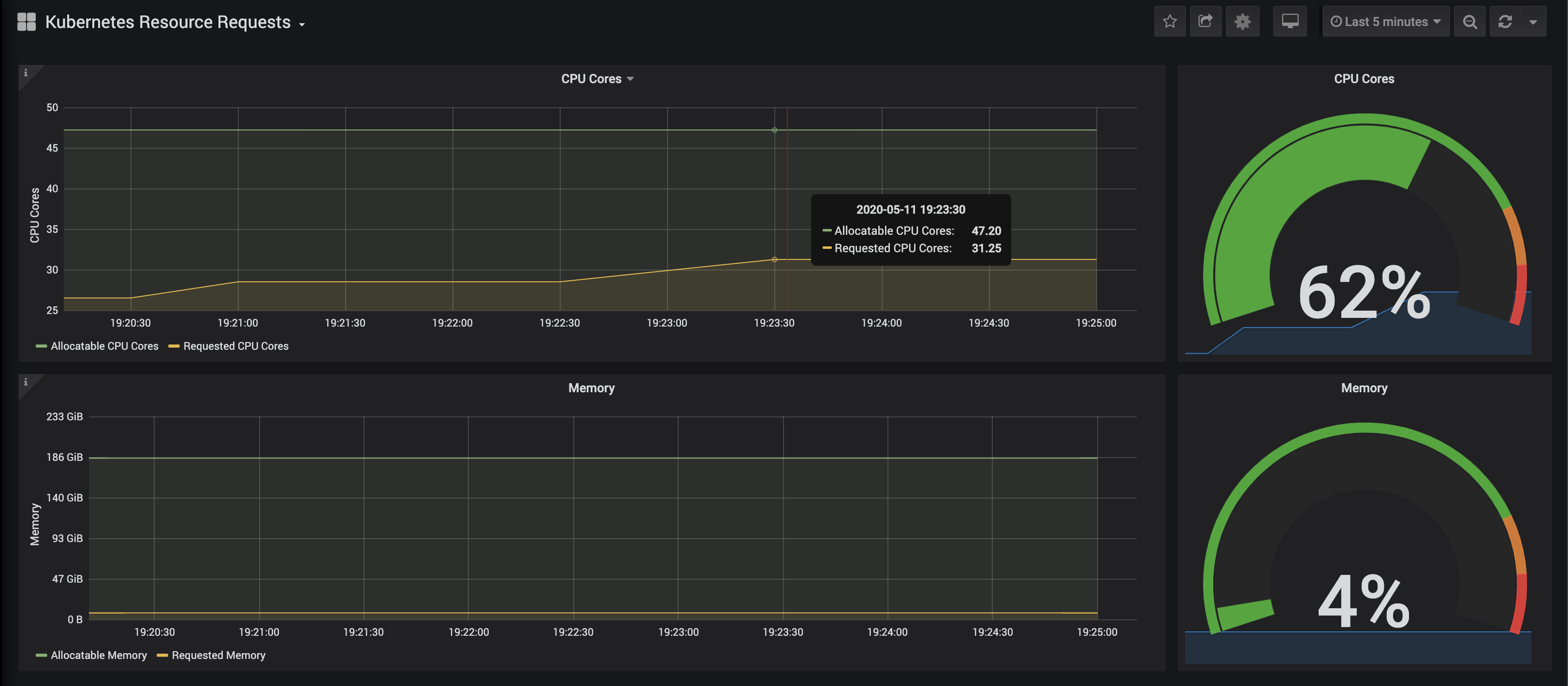
For now, we have a running Kubernetes cluster, on bare-metal (on top of Packet), with 3 nodes, a running Knative installation that serves and scales Docker images.
Mysql
Finally, let’s add some state to this setup. At Presslabs, the company I’m currently working for, we’ve built an operator for MySQL. It takes care of replication, backups, and other tedious operations. The installation and its configuration are fairly straight forward, but first, we need to configure some persistent volumes:
apiVersion: v1
kind: PersistentVolume
metadata:
labels:
type: local
name: rabbit-1.vtemian.com
spec:
accessModes:
- ReadWriteOnce
capacity:
storage: 11Gi
hostPath:
path: /mnt/data
type: ""
nodeAffinity:
required:
nodeSelectorTerms:
- matchExpressions:
- key: kubernetes.io/hostname
operator: In
values:
- rabbit-1.vtemian.com
persistentVolumeReclaimPolicy: Retain
storageClassName: standard
volumeMode: Filesystem
Let’s create one for each node:
╰─>$ kubectl get pv
NAME CAPACITY ACCESS MODES RECLAIM POLICY STATUS CLAIM STORAGECLASS REASON AGE
rabbit-1.vtemian.com 11Gi RWO Retain Available standard 2m58s
rabbit-2.vtemian.com 11Gi RWO Retain Bound default/data-mysql-operator-0 standard 3m9s
rabbit-3.vtemian.com 11Gi RWO Retain Available standard 3m19s
We now can continue with mysql-operator:
╰─>$ helm repo add presslabs https://presslabs.github.io/charts
╰─>$ helm install presslabs/mysql-operator --name mysql-operator --set orchestrator.persistence.storageClass=standard
Furthermore, we’ll need a secret with the credentials we want for our mysql cluster
apiVersion: v1
kind: Secret
metadata:
name: my-secret
type: Opaque
data:
ROOT_PASSWORD: bXlwYXNz
DATABASE: cmFiYml0Cg==
USER: cmFiYml0Cg==
PASSWORD: bXlwYXNz
And create the cluster with 2 replicas
apiVersion: mysql.presslabs.org/v1alpha1
kind: MysqlCluster
metadata:
name: my-cluster
spec:
replicas: 2
secretName: my-secret
Now we have our 2 replicas:
╰─>$ kubectl get po -l app.kubernetes.io/name=mysql
NAME READY STATUS RESTARTS AGE
my-cluster-mysql-0 4/4 Running 0 3m11s
my-cluster-mysql-1 4/4 Running 0 4m37s
And a service on which we can connect:
╰─>$ kubectl get service -l app.kubernetes.io/name=mysql
NAME TYPE CLUSTER-IP EXTERNAL-IP PORT(S) AGE
my-cluster-mysql ClusterIP 10.233.50.17 <none> 3306/TCP 10m
my-cluster-mysql-master ClusterIP 10.233.29.255 <none> 3306/TCP 10m
At this point, the serving component is up and running and tested with a dummy application. Let’s move further with the building component.
CI/CD
Tekton
Knative used to have a build component, which now is deprecated in favour of Tekton. There are some nice guides on how to configure Tekton and integrate it with Knative, but first, let’s install it:
╰─>$ kubectl apply --filename https://storage.googleapis.com/tekton-releases/pipeline/latest/release.yaml
Finally, we just need to edit the config-artifact-pvc ConfigMap, in order to allow Tekton to save artifacts in a PVC.
data:
size: 5Gi
storageClassName: default
Taking a look at Tekton pod’s we can see that it’s running properly:
╰─>$ kubectl get po -n tekton-pipelines
NAME READY STATUS RESTARTS AGE
tekton-pipelines-controller-5c44bcfc44-gfhdx 1/1 Running 0 85m
tekton-pipelines-webhook-7bd568f6c6-vll6v 1/1 Running 0 85m
How does Tekton work?
Before setting up the pipeline, let’s explore Tekton a little bit. Tekton leverages CRDs and allow us to describe pipelines by defining Kubernetes resources. I’ll resume the information from this guide and their official docs.
Tasks are a template for defining an actual working unit. It’s like defining a function, with its parameters and behavior. It defines one or more steps and at each step, a container is executed. Example from https://github.com/knative-sample/tekton-knative
apiVersion: tekton.dev/v1alpha1
kind: Task
metadata:
name: deploy-using-kubectl
spec:
inputs:
resources:
- name: git-source
type: git
params:
- name: pathToYamlFile
description: The path to the yaml file to deploy within the git source
- name: imageUrl
description: Url of image repository
- name: imageTag
description: Tag of the images to be used.
default: "latest"
steps:
- name: update-yaml
image: alpine
command: ["sed"]
args:
- "-i"
- "-e"
- "s;__IMAGE__;${inputs.params.imageUrl}:${inputs.params.imageTag};g"
- "/workspace/git-source/${inputs.params.pathToYamlFile}"
- name: run-kubectl
image: registry.cn-hangzhou.aliyuncs.com/knative-sample/kubectl:v0.5.0
command: ["kubectl"]
args:
- "apply"
- "-f"
- "/workspace/git-source/${inputs.params.pathToYamlFile}"
A TaskRun is a running instance of a Task. It executes all the steps of a task, in order, until all of them are completed. Example from https://github.com/knative-sample/tekton-knative
apiVersion: tekton.dev/v1alpha1
kind: TaskRun
metadata:
name: source-to-image
spec:
taskRef:
name: source-to-image
params:
- name: pathToContext
value: "${params.pathToContext}"
- name: imageUrl
value: "${params.imageUrl}"
- name: imageTag
value: "${params.imageTag}"
resources:
inputs:
- name: git-source
resource: git-source
A Pipeline allows us to define multiple tasks. Using TaskRun we could run only one task. Each Task in a Pipeline executes as a Pod. Example from https://github.com/knative-sample/tekton-knative
apiVersion: tekton.dev/v1alpha1
kind: Pipeline
metadata:
name: build-and-deploy-pipeline
spec:
resources:
- name: git-source
type: git
params:
- name: pathToContext
description: The path to the build context, used by Kaniko - within the workspace
default: src
- name: pathToYamlFile
description: The path to the yaml file to deploy within the git source
- name: imageUrl
description: Url of image repository
- name: imageTag
description: Tag to apply to the built image
tasks:
- name: source-to-image
taskRef:
name: source-to-image
params:
- name: pathToContext
value: "${params.pathToContext}"
- name: imageUrl
value: "${params.imageUrl}"
- name: imageTag
value: "${params.imageTag}"
resources:
inputs:
- name: git-source
resource: git-source
- name: deploy-to-cluster
taskRef:
name: deploy-using-kubectl
runAfter:
- source-to-image
params:
- name: pathToYamlFile
value: "${params.pathToYamlFile}"
- name: imageUrl
value: "${params.imageUrl}"
- name: imageTag
value: "${params.imageTag}"
resources:
inputs:
- name: git-source
resource: git-source
Similar to TaskRun, PipelineRun executes all the tasks defined in a Pipeline. Example from https://github.com/knative-sample/tekton-knative
apiVersion: tekton.dev/v1alpha1
kind: PipelineRun
metadata:
generateName: tekton-kn-sample-
spec:
pipelineRef:
name: build-and-deploy-pipeline
resources:
- name: git-source
resourceRef:
name: tekton-knative-git
params:
- name: pathToContext
value: "src"
- name: pathToYamlFile
value: "knative/helloworld-go.yaml"
- name: imageUrl
value: "registry.cn-hangzhou.aliyuncs.com/knative-sample/tekton-knative-helloworld"
- name: imageTag
value: "1.0"
trigger:
type: manual
serviceAccount: pipeline-account
PipelineResources allows us to define objects that are used by tasks’ inputs and outputs. Example from https://github.com/knative-sample/tekton-knative
apiVersion: tekton.dev/v1alpha1
kind: PipelineResource
metadata:
name: tekton-knative-git
spec:
type: git
params:
- name: revision
value: master
- name: url
value: https://github.com/knative-sample/tekton-knative
Pipeline setup
Those are all the major components that we’ll play with.
Let’s create a new namespace called ci and install the above manifests, adapted for our needs. I’ve commited the changes in the example app.
╰─>$ kubectl get po
NAME READY STATUS RESTARTS AGE
tekton-simple-django-app-1-deploy-to-cluster-982xv-pod-kkmpw 0/3 Completed 0 3m18s
tekton-simple-django-app-1-source-to-image-8c47t-pod-ccc44 0/3 Completed 0 3m44s
╰─>$ kubectl get pipelinerun
NAME SUCCEEDED REASON STARTTIME COMPLETIONTIME
tekton-simple-django-app-1 True Succeeded 2m14s 95s
Github webhook trigger
Right now, we manually have to trigger the build by deleting and re-creating the Pipelinerun resource. Let’s try to automate it, by configuring a Github webhook that will ping the building process each time a new commit is made.
The setup for that is not too complex, nor too simple. When a github hook arrives, it lands in an [EventListener](https://tekton.dev/docs/triggers/eventlisteners/) pod (that will need to be exposed to the Internet via Istio). From its payload, we’ll need to extract relevant parameters, like commit information. For that, we’ll be using TriggerBindings. The parameters are then used by TriggerTemplate to generate our pipeline run. The following configurations are inspired by @nikhilthomas1.

Let’s create the a role, service account and the role binding for this process.
---
apiVersion: rbac.authorization.k8s.io/v1
kind: Role
rules:
- apiGroups:
- triggers.tekton.dev
resources:
- eventlisteners
- triggerbindings
- triggertemplates
- pipelineresources
verbs:
- get
- apiGroups:
- triggers.tekton.dev
resources:
- pipelineruns
- pipelineresources
verbs:
- create
- apiGroups:
- ""
resources:
- configmaps
verbs:
- get
- list
- create
- update
- delete
---
apiVersion: v1
kind: ServiceAccount
metadata:
name: tekton-triggers-sa
---
apiVersion: rbac.authorization.k8s.io/v1
kind: RoleBinding
metadata:
name: tekton-triggers-rolebinding
subjects:
- kind: ServiceAccount
name: tekton-triggers-sa
roleRef:
apiGroup: rbac.authorization.k8s.io
kind: Role
name: tekton-triggers-role⏎
TriggerTemplate is very basic. It describes some parameters that can be used, from the binding and it patches them together with PipelineRun and other resources:
apiVersion: triggers.tekton.dev/v1alpha1
kind: TriggerTemplate
metadata:
name: tekton-triggertemplate
spec:
params:
- name: gitrevision
description: The git revision
default: master
- name: gitrepositoryurl
description: The git repository url
- name: namespace
description: The namespace to create the resources
- name: gitrepositoryname
description: The name of the deployment to be created / patched
resourcetemplates:
- apiVersion: tekton.dev/v1alpha1
kind: PipelineResource
metadata:
name: source-repo-$(params.gitrepositoryname)-$(uid)
namespace: $(params.namespace)
spec:
type: git
params:
- name: revision
value: $(params.gitrevision)
- name: url
value: $(params.gitrepositoryurl)
- apiVersion: tekton.dev/v1alpha1
kind: PipelineRun
metadata:
name: teokton-build-$(params.gitrepositoryname)-$(uid)
namespace: $(params.namespace)
spec:
pipelineRef:
name: build-and-deploy-pipeline
serviceAccountName: pipeline-account
resources:
- name: git-source
resourceRef:
name: source-repo-$(params.gitrepositoryname)-$(uid)
params:
- name: pathToContext
value: ""
- name: pathToDockerFile
value: Dockerfile
- name: pathToYamlFile
value: knative.yaml
- name: imageUrl
value: docker.io/vtemian/$(params.gitrepositoryname)
- name: imageTag
value: latest
Our TriggerBinding will also be pretty simple. Just a mapping from Github’s payload to the parameters used in TriggerTemplate
apiVersion: triggers.tekton.dev/v1alpha1
kind: TriggerBinding
metadata:
name: tekton-pipelinebinding
spec:
params:
- name: gitrevision
value: $(body.head_commit.id)
- name: namespace
value: default
- name: gitrepositoryurl
value: $(body.repository.url)
- name: gitrepositoryname
value: $(body.repository.name)
Finally, we’ll need the EventListener, with binds a TemplateTrigger with a TemplateBinding
apiVersion: triggers.tekton.dev/v1alpha1
kind: EventListener
metadata:
name: el-tekton-listener
spec:
serviceAccountName: tekton-triggers-sa
triggers:
- bindings:
- name: tekton-pipelinebinding
template:
name: tekton-triggertemplate
╰─>$ kubectl get service | grep tek
el-tekton-listener ClusterIP 10.233.47.3 <none> 8080/TCP 114m
Now that we have the service, we’ll just need to expose it using Istio’s primitives. Let’s use Tekton’s tools for that, using a separate service account:
kind: Role
apiVersion: rbac.authorization.k8s.io/v1
metadata:
name: tekton-triggers-createwebhook
rules:
- apiGroups:
- ""
resources:
- secrets
verbs:
- get
- list
- create
- update
- delete
- apiGroups:
- tekton.dev
resources:
- eventlisteners
verbs:
- get
- list
- create
- update
- delete
- apiGroups:
- extensions
resources:
- ingresses
verbs:
- create
- get
- list
- delete
- update
---
apiVersion: v1
kind: ServiceAccount
metadata:
name: tekton-triggers-createwebhook
---
apiVersion: rbac.authorization.k8s.io/v1
kind: RoleBinding
metadata:
name: tekton-triggers-createwebhook
subjects:
- kind: ServiceAccount
name: tekton-triggers-createwebhook
roleRef:
apiGroup: rbac.authorization.k8s.io
kind: Role
name: tekton-triggers-createwebhook⏎
Following by the task itself:
apiVersion: tekton.dev/v1beta1
kind: Task
spec:
params:
- description: The external domain for the EventListener
name: ExternalDomain
type: string
- description: The name of the Service used in the VirtualService
name: Service
type: string
- description: The service port that the VirtualService is being created on
name: ServicePort
type: string
steps:
- args:
- -ce
- |
set -ex
cat << EOF | kubectl create -f -
apiVersion: networking.istio.io/v1alpha3
kind: Gateway
metadata:
name: $(inputs.params.Service)-gateway
spec:
selector:
istio: ingressgateway
servers:
- port:
number: 80
name: http-$(inputs.params.Service)
protocol: HTTP
hosts:
- $(inputs.params.ExternalDomain)
---
apiVersion: networking.istio.io/v1alpha3
kind: VirtualService
metadata:
name: $(inputs.params.Service)-virtual-service
spec:
hosts:
- $(inputs.params.ExternalDomain)
gateways:
- $(inputs.params.Service)-gateway
http:
- route:
- destination:
host: $(inputs.params.Service)
port:
number: $(inputs.params.ServicePort)
EOF
command:
- sh
image: lachlanevenson/k8s-kubectl:latest
name: create-istio-gateway-virtualservice
resources: {}
volumes:
- emptyDir: {}
name: work
And ending with it’s initialisation:
apiVersion: tekton.dev/v1beta1
kind: TaskRun
metadata:
spec:
params:
- name: ExternalDomain
value: simple-django-app-event-listner.default.147.75.80.160.xip.io
- name: Service
value: el-tekton-listener
- name: ServicePort
value: "8080"
serviceAccountName: tekton-triggers-createwebhook
taskRef:
kind: Task
name: create-istio-gateway-virtualservice
timeout: 1h0m0s
And let’s check the result:
╰─>$ kubectl get VirtualService
NAME GATEWAYS HOSTS AGE
el-tekton-listener-virtual-service [el-tekton-listener-gateway] [simple-django-app-event-listner.default.147.75.80.160.xip.io]
Now that we have the tools up and running in our cluster, we can create the webhook. For that, we’ll need a Github personal token, stored in a secret
apiVersion: v1
kind: Secret
metadata:
name: webhook-secret
stringData:
#https://help.github.com/en/github/authenticating-to-github/creating-a-personal-access-token-for-the-command-line#creating-a-token
token: <token>
secret: random-string-data
The task that will actually create the webhook
apiVersion: tekton.dev/v1alpha1
kind: Task
metadata:
name: create-webhook
spec:
volumes:
- name: github-secret
secret:
secretName: $(inputs.params.GitHubSecretName)
inputs:
params:
- name: ExternalDomain
description: "The external domain for the EventListener e.g. `$(inputs.params.EventListenerName).<PROXYIP>.nip.io`"
- name: GitHubUser
description: "The GitHub user"
- name: GitHubRepo
description: "The GitHub repo where the webhook will be created"
- name: GitHubOrg
description: "The GitHub organization where the webhook will be created"
- name: GitHubSecretName
description: "The Secret name for GitHub access token. This is always mounted and must exist"
- name: GitHubAccessTokenKey
description: "The GitHub access token key name"
- name: GitHubSecretStringKey
description: "The GitHub secret string key name"
- name: GitHubDomain
description: "The GitHub domain. Override for GitHub Enterprise"
default: "github.com"
- name: WebhookEvents
description: "List of events the webhook will send notifications for"
default: '[\"push\",\"pull_request\"]'
steps:
- name: create-webhook
image: pstauffer/curl:latest
volumeMounts:
- name: github-secret
mountPath: /var/secret
command:
- sh
args:
- -ce
- |
set -e
echo "Create Webhook"
if [ $(inputs.params.GitHubDomain) = "github.com" ];then
curl -v -d "{\"name\": \"web\",\"active\": true,\"events\": $(inputs.params.WebhookEvents),\"config\": {\"url\": \"$(inputs.params.ExternalDomain)\",\"content_type\": \"json\",\"insecure_ssl\": \"1\" ,\"secret\": \"$(cat /var/secret/$(inputs.params.GitHubSecretStringKey))\"}}" -X POST -u $(inputs.params.GitHubUser):$(cat /var/secret/$(inputs.params.GitHubAccessTokenKey)) -L https://api.github.com/repos/$(inputs.params.GitHubOrg)/$(inputs.params.GitHubRepo)/hooks
else
curl -d "{\"name\": \"web\",\"active\": true,\"events\": $(inputs.params.WebhookEvents),\"config\": {\"url\": \"$(inputs.params.ExternalDomain)/\",\"content_type\": \"json\",\"insecure_ssl\": \"1\" ,\"secret\": \"$(cat /var/secret/$(inputs.params.GitHubSecretStringKey))\"}}" -X POST -u $(inputs.params.GitHubUser):$(cat /var/secret/$(inputs.params.GitHubAccessTokenKey)) -L https://$(inputs.params.GitHubDomain)/api/v3/repos/$(inputs.params.GitHubOrg)/$(inputs.params.GitHubRepo)/hooks
fi
And it’s initialization
apiVersion: tekton.dev/v1alpha1
kind: TaskRun
metadata:
name: create-api-repo-webhook-run
spec:
taskRef:
name: create-webhook
inputs:
params:
- name: GitHubOrg
value: "vtemian"
- name: GitHubUser
value: "vtemian"
- name: GitHubRepo
value: "simple-django-app"
- name: GitHubSecretName
value: webhook-secret
- name: GitHubAccessTokenKey
value: token
- name: GitHubSecretStringKey
value: secret
- name: ExternalDomain
value: http://simple-django-app-event-listner.default.147.75.80.160.xip.io
timeout: 1000s
serviceAccountName: tekton-triggers-createwebhook

Now, each time we push new changes, a new build is being trigger:
╰─>$ kubectl get po | grep teo
teokton-build-simple-django-app-2fcdr-source-to-image-v86-mwxhw 0/3 Error 0 71m
teokton-build-simple-django-app-qlw5w-source-to-image-sz2-gpqdm 0/3 Error 0 73m
teokton-build-simple-django-app-sl9zf-source-to-image-knl-tzxpk 1/3 Running 0 18s
teokton-build-simple-django-app-xh54x-deploy-to-cluster-b-5p7r4 0/3 Completed 0 66m
teokton-build-simple-django-app-xh54x-source-to-image-wv5-9bsdt 0/3 Completed 0 66m
And the application is being deployed
╰─>$ kubectl get po | grep simple
simple-django-app-cjx8b-deployment-7cd5c5999d-vwjhv 2/2 Running 0 4h3m
simple-django-app-d2n6n-deployment-77c664bf4f-pz6hg 2/2 Running 0 4h29m
simple-django-app-hcmpl-deployment-7687b96b5f-pv2wz 2/2 Running 0 67m
Conclusions
In the end, we’ve managed to configure a bare-metal infrastructure, install Knative and have a CI/CD that builds and deploys new versions of our application, on git push. It’s a little bit of a hassle and we left behind some details regarding revisions, routing and blue-green deployments.
Platforms like Vercel, Heroku, Google Cloud Run and AWS ECS are truly remarkable, from an engineering point of view and because they lift the burden of deploying your application and manage your infrastructure. Kudos to Knative and Tekton for bringing such platforms closer to our reach.
Cheers 🍺!
Thanks @catileptic for the awesome illustrations!